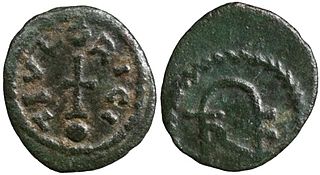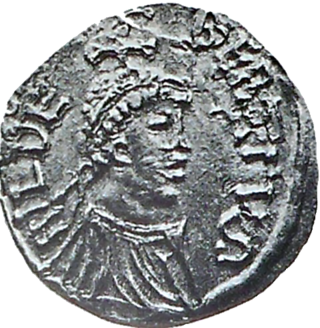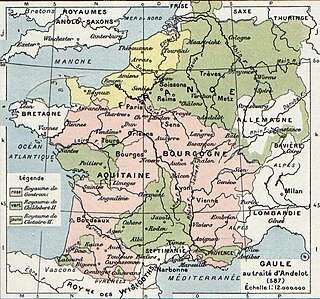Sources
- Fuchs, Karlheinz; Kempa, Martin; Redies, Rainer. Die Alamannen (Ausstellungskatalog). Stuttgart: Verlag Theiß, 2001. ISBN 3-8062-1535-9.
- Geuenich, Dieter. Geschichte der Alemannen. Stuttgart: Kohlhammer Verlag, 2004. ISBN 3-17-018227-7.
Uncelen, Uncelin, or Uncilin (from Latin Uncelenus; died c. 613) was the Duke of Alemannia from 587 to 607. He was appointed to replace Leutfred by the Austrasian king Childebert II.
On Childebert's death in 595, the Thurgau, Kembsgau, and Alsace passed to the Kingdom of Burgundy, then under the rule of Theuderic II.
In 605 Theuderic went to war with his brother Theudebert II, who ruled Austrasia. His army, which did not wish to go to war, he placed under the command of his majordomo Protadius with instructions to induce the soldiers to fight. The next year (606) at Quierzy-sur-Oise, Theuderic re-assembled the army, but the men once again refused to fight their countrymen and the king ordered Uncelen to coerce them. Uncelen, however, declared that the king had ordered the Protadius' death. The despised majordomo was killed by the warriors and the king was forced to sign a treaty. Queen Brunhilda, who had induced Theuderic to war, had Uncelen's foot cut off. According to the Lex Alamannorum , a duke was only eligible for office if he could mount a horse. Being unable to continue exercising his office, Uncelen was removed.

Year 606 (DCVI) was a common year starting on Saturday of the Julian calendar. The denomination 606 for this year has been used since the early medieval period, when the Anno Domini calendar era became the prevalent method in Europe for naming years.

Year 607 (DCVII) was a common year starting on Sunday of the Julian calendar. The denomination 607 for this year has been used since the early medieval period, when the Anno Domini calendar era became the prevalent method in Europe for naming years.

Year 595 (DXCV) was a common year starting on Saturday of the Julian calendar. The denomination 595 for this year has been used since the early medieval period, when the Anno Domini calendar era became the prevalent method in Europe for naming years.

Theuderic I was the Merovingian king of Metz, Rheims, or Austrasia—as it is variously called—from 511 to 534.

Austrasia was the northeastern kingdom within the core of the Frankish Empire during the Early Middle Ages, centring on the Meuse, Middle Rhine and the Moselle rivers. It included the original Frankish-ruled territories within what had been the northernmost part of Roman Gaul, and cities such as Cologne, Trier and Metz. It also stretched beyond the old Roman borders on the Rhine into Frankish areas which had never been formally under Roman rule. It came into being as a part of the Frankish Empire founded by Clovis I (481–511). At the same time, the initial powerbase of Clovis himself was the more Romanized part of northern Gaul, lying southwest of Austrasia, which came to be known as Neustria.

Chlothar II, sometimes called "the Young", was king of the Franks, ruling Neustria (584–629), Burgundy (613–629) and Austrasia (613–623).

The Carolingian dynasty was a Frankish noble family named after Charles Martel and his grandson Charlemagne, descendants of the Arnulfing and Pippinid clans of the 7th century AD. The dynasty consolidated its power in the 8th century, eventually making the offices of mayor of the palace and dux et princeps Francorum hereditary, and becoming the de facto rulers of the Franks as the real powers behind the Merovingian throne. In 751 the Merovingian dynasty which had ruled the Franks was overthrown with the consent of the Papacy and the aristocracy, and Pepin the Short, son of Martel, was crowned King of the Franks. The Carolingian dynasty reached its peak in 800 with the crowning of Charlemagne as the first Emperor of the Romans in the West in over three centuries. Nearly every monarch of France from Charlemagne's son Louis the Pious until the penultimate monarch of France Louis Philippe have been his descendants. His death in 814 began an extended period of fragmentation of the Carolingian Empire and decline that would eventually lead to the evolution of the Kingdom of France and the Holy Roman Empire.

Chlothar I, sometime called "the Old", also anglicised as Clotaire, was a king of the Franks of the Merovingian dynasty and one of the four sons of Clovis I.

Childebert I was a Frankish King of the Merovingian dynasty, as third of the four sons of Clovis I who shared the kingdom of the Franks upon their father's death in 511. He was one of the sons of Saint Clotilda, born at Reims. He reigned as King of Paris from 511 to 558 and Orléans from 524 to 558.

The Kingdom of the Franks, also known as the Frankish Kingdom, the Frankish Empire or Francia, was the largest post-Roman barbarian kingdom in Western Europe. It was ruled by the Frankish Merovingian and Carolingian dynasties during the Early Middle Ages. Francia was among the last surviving Germanic kingdoms from the Migration Period era.

Theuderic III was King of the Franks in the 7th century. He ruled Neustria and Burgundy on two occasions, as well as Austrasia from 679 until his death in 691.
Brunhilda was queen consort of Austrasia, part of Francia, by marriage to the Merovingian king Sigebert I of Austrasia, and regent for her son, grandson and great-grandson.

Theuderic II, king of Burgundy (595–613) and Austrasia (612–613), was the second son of Childebert II. At his father's death in 595, he received Guntram's kingdom of Burgundy, with its capital at Orléans, while his elder brother, Theudebert II, received their father's kingdom of Austrasia, with its capital at Metz. He also received the lordship of the cities (civitates) of Toulouse, Agen, Nantes, Angers, Saintes, Angoulême, Périgueux, Blois, Chartres, and Le Mans. During his minority, and later, he reigned under the guidance of his grandmother Brunhilda, evicted from Austrasia by his brother Theudebert II.

Childebert III, called the Just, was the son of Theuderic III and Chrothildis and sole king of the Franks (694–711). He was seemingly but a puppet of the mayor of the palace, Pepin of Heristal, though his placita show him making judicial decisions of his own will, even against the Arnulfing clan. His nickname has no comprehensible justification except possibly as a result of these judgements, but the Liber Historiae Francorum calls him a "famous man" and "the glorious lord of good memory, Childebert, the just king."

Chlothar IV was the king of Austrasia from 717 until his death. He was a member of the Merovingian dynasty, and was installed by Charles Martel, a contender for the office of mayor of the palace, in opposition to Chilperic II, whose rule was thereby restricted to Neustria. This marked the first time since 679 that the kingdom of the Franks was divided. Following Chlothar's death, it was reunited under Chilperic.
Berthoald was the mayor of the palace of Burgundy from some time before 603 until his death in the next year. According to the Burgundian chronicler Fredegar, he was moderate, sensible, brave, and honest.
Protadius was the mayor of the palace of Burgundy from 604, when he displaced his rival Berthoald, until his death two years later. He was originally the noble lover of Brunhilda, the grandmother of and regent for King Theuderic II. She, however, desired to raise him to status in the kingdom and had him given the patricianship over the lands east of the Jura, whose duke, Wandalmar, had died in 604. She then conspired to do away with Berthoald, mayor of the palace, by sending him with only 300 men to the region of the Seine. Attacked by Clotaire II of Neustria's son, Merovech, and his mayor, Landric, Berthoald died in the ensuing battle when he realised that he had nothing to lose, for he was no longer safe at court.
The Duchy of Alsace was a large political subdivision of the Frankish Empire during the last century and a half of Merovingian rule. It corresponded to the territory of Alsace and was carved out of southern Austrasia in the last decade of the reign of Dagobert I, probably to stabilise the southern reaches of Austrasia against Alemannia and Burgundy. By the late Middle Ages, the region was considered part of Swabia.
The 600s decade ran from January 1, 600, to December 31, 609.